Shubunkins are a hardy, single-tailed goldfish with nacreous scales and a pattern known as calico. The Shubunkins are of Japanese origin.

Calico goldfish are goldfish of any breed that have a type of scale that is intermediate between the metallic type of scales and the transparent type. These scales have a slight sheen that produces a pearly appearance. The name "calico goldfish" came about because the first fish that were introduced with this type of scales had a mottled calico pattern with several colours.

The Bubble Eye is a small variety of fancy goldfish with upward-pointing eyes that are accompanied by two large fluid-filled sacs. It is a dorsal-less fish – good specimens will have a clean back and eye bubbles that match in color and size. Their bubbles are quite delicate, so the fish should be kept separately from boisterous types, as well as sharp tank decor. Although the bubbles will regrow if punctured, an injury could leave the fish prone to infections. The bubbles can disadvantage the fish as it is not a strong swimmer, with a seemingly low bobbing head at times; bubbles are infamous for being sucked into filters and siphons in an aquarium.

The comet or comet-tailed goldfish is a single-tailed goldfish bred in the United States. It is similar to the common goldfish, except slightly smaller and slimmer, and is mainly distinguished by its long deeply forked tail. Comet goldfish tend to have a diverse variety of colors, unlike the common goldfish.

The telescope eye is a goldfish characterised by its protruding eyes. It was first developed in the early 1700s in China, where the trait was referred to as dragon eyes.

The ryukin is a short deep-bodied fancy goldfish with a characteristic hump in the shoulder region.

An oranda is a breed of goldfish characterized by a prominent bubble-like "hood" on the head. The headgrowth or hood may be a prominent growth on the top of the head or may encase the entire face except the mouth.
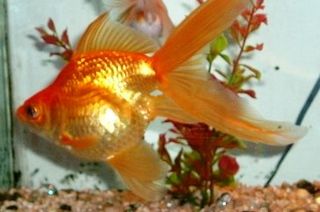
The Fantail is a goldfish that possesses an egg-shaped body, a high dorsal fin, a long quadruple caudal fin, and no shoulder hump. It is similar to the Ryukin, and is relatively common in western countries.

The lionhead is a hooded variety of fancy goldfish. This fish is the precursor to the ranchu.

The Ranchu is a hooded variety of goldfish native to China. It is referred to as the 'king of goldfish" by the Japanese. Maruko more commonly refers to the egg-fish goldfish.
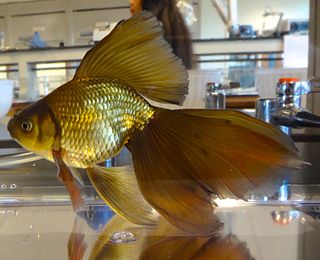
The veiltail is a type of goldfish known for its extra-long, flowing double tail and high sail-like dorsal fin.
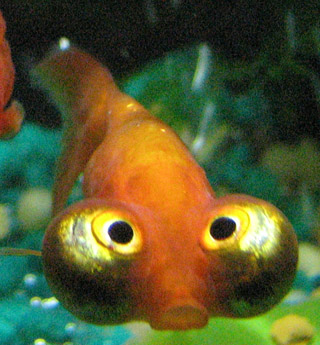
Celestial eye goldfish or Choutengan is a double-tailed breed of fancy goldfish that has a breed-defining pair of telescope eyes which are turned upwards, pupils gazing skyward. When the fry hatch, the eyes of young Celestials are normal but gradually protrude sideways, as in the Telescope eye goldfish, but unlike the telescope, which has eyes facing outwards on each side, the eyes of the celestial eye turns strictly upwards within a period of six months of development. This process is entirely governed by genetics, though early sources perpetuated the myth that the fish were bred and kept in narrow-necked clay jars and the eyes turned upwards seeking the limited source of light.
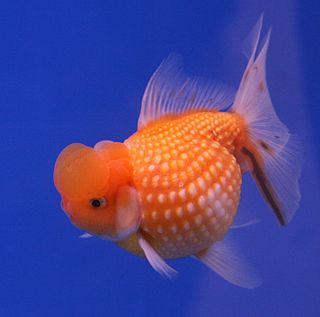
The Pearlscale is a spherical-bodied fancy goldfish with doubled finnage similar to the fantail.

The Lionchu or lionhead-ranchu is a variety of goldfish that has resulted from crossbreeding lionheads and ranchus.
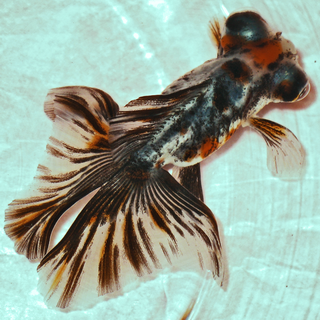
The Butterfly telescope goldfish is a variant of telescope goldfish that is distinguished by the butterfly-shaped caudal fins when viewed from above. It is a variety that has only recently been deemed a major lineage by a few published works. The tail conformation is commonly bred into the telescope eye goldfish, the term "butterfly tail" is just short for the many names this variety has such as Butterfly Tail Demekin, Butterfly Tail Black Moor and Top view Telescope (TVT), and many other goldfish varieties.

The Meteor goldfish is considered the rarest breed of goldfish. They are a tailless form thought to have been developed by goldfish breeders during the late 19th or early 20th century. The meteor goldfish lacked a tail fin, but had a well-developed anal fin in its position. The other fins of the meteor goldfish were elongated, and it was a competent swimmer despite its lack of a tail. Few swim like other normal goldfish and few swim straight ahead like a rocket, the rocket swimming being rarer. Whilst rare the meteor is also one of the hardest to breed, they can be very weak and in low temperatures sicken easily.
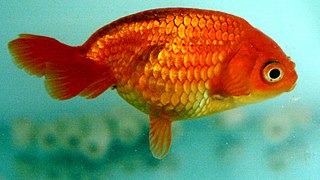
The egg fish goldfish is a fancy goldfish breed which lacks a dorsal fin and has a pronounced egg-shaped body. They look like ranchu but lack the "hood" or wen commonly found on ranchu goldfish, they also tend to have longer bodies.

A freshwater aquarium is a receptacle that holds one or more freshwater aquatic organisms for decorative, pet-keeping, or research purposes. Modern aquariums are most often made from transparent glass or acrylic glass. Typical inhabitants include fish, plants, amphibians, and invertebrates, such as snails and crustaceans.

The Goldfish is a freshwater fish in the family Cyprinidae of order Cypriniformes. It is commonly kept as a pet in indoor aquariums, and is one of the most popular aquarium fish. Goldfish released into the wild have become an invasive pest in parts of North America.



















